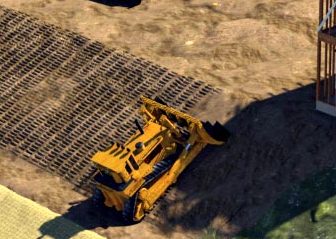Surface Roughening

Definition
Roughening a bare soil surface with horizontal grooves running across the slope, stair stepping, or tracking with construction equipment; or by leaving slopes in a roughened condition by not fine grading them.
Purpose
To aid the establishment of vegetative cover from seed, to reduce runoff velocity and increase infiltration, and to reduce erosion and provide for sediment trapping.
Where Practice Applies
All construction slopes require surface roughening to facilitate stabilization with vegetation, particularly slopes steeper than 3:1. This practice should also be done prior to forecasted storm events and before leaving a job site for a weekend.
Advantages
Surface roughening provides some instant erosion protection on bare soil while vegetative cover is being established. It is an inexpensive and simple erosion control measure.
Disadvantages/Problems
While this is a cheap and simple method of erosion control, it is of limited effectiveness in anything more than a moderate storm. Surface roughening is a temporary measure. If roughening is washed away in a heavy storm, the surface will have to be re-roughened and new seed laid.
Planning Considerations
- Roughening a sloping bare soil surface with horizontal depressions helps control erosion by aiding the establishment of vegetative cover with seed, reducing runoff velocity, and increasing infiltration. The depressions also trap sediment on the face of the slope.
- Consider surface roughening for all slopes. The amount of roughening required depends on the steepness of the slope and the type of soil. Stable, sloping rocky faces may not require roughening or stabilization, while erodible slopes steeper than 3:1 require special surface roughening.
- Roughening methods include stair-step grading, grooving, and tracking. Equipment such as bulldozers with rippers or tractors with disks may be used. The final face of slopes should not be bladed or scraped to give a smooth hard finish.
- Graded areas with smooth, hard surfaces give a false impression of "finished grading" and a job well done. It is difficult to establish vegetation on such surfaces due to reduced water infiltration and the potential for erosion. Rough slope surfaces with uneven soil and rocks left in place may appear unattractive or unfinished at first, but they encourage water infiltration, speed the establishment of vegetation, and decrease runoff velocity.
- Rough, loose soil surfaces give lime, fertilizer, and seed some natural coverage. Niches in the surface provide microclimates which generally provide a cooler and more favorable moisture level than hard flat surfaces; this aids seed germination.
Construction Recommendations
- Roughening methods include stair-step grading, grooving, and tracking. Factors to be considered in choosing a method are slope steepness, mowing requirements, and whether the slope is formed by cutting or filling.
- Graded areas with slopes greater than 3:1 but less than 2:1 should be roughened before seeding. This can be accomplished in a variety of ways, including "track walking," or driving a crawler tractor up and down the slope, leaving a pattern of cleat imprints parallel to slope contours.
- Graded areas steeper than 2:1 should be stair-stepped with benches. The stairstepping will help vegetation become established and also trap soil eroded from the slopes above.
- Disturbed areas which will not require mowing may be stair-step graded, grooved, or left rough after filling.
- Stair-step grading is appropriate for soils containing large amounts of soft rock. Each "step" catches material that sloughes from above, and provides a level site where vegetation can become established. Stairs should be wide enough to work with standard earth moving equipment.
- Areas which will be mowed (these areas should have slopes less steep than 3:1) may have small furrows left by disking, harrowing, raking, or seed-planting machinery operated on the contour.
- It is important to avoid excessive compacting of the soil surface when scarifying. Tracking with bulldozer treads is preferable to not roughening at all, but is not as effective as other forms of roughening, as the soil surface is severely compacted and runoff is increased.
Maintenance
Areas which are graded in this manner should be seeded as quickly as possible. Regular inspections should be made. If rills appear, they should be regraded and reseeded immediately.
References
Massachusetts Department of Environmental Protection, Office of Watershed Management, Nonpoint Source Program, Massachusetts Nonpoint Source Management Manual, Boston, Massachusetts, June, 1993.
U.S. Environmental Protection Agency, Storm Water Management For Construction Activities, EPA-832-R92-005, Washington, DC, September, 1992.
Washington State Department of Ecology, Stormwater Management Manual for the Puget Sound Basin, Olympia, WA, February, 1992.